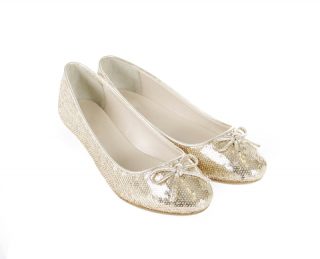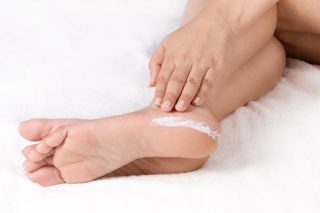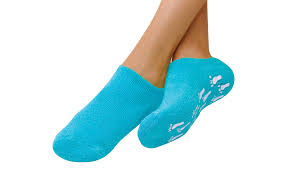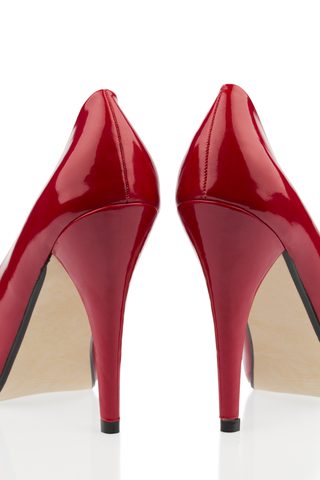
Written by Michelle Champlin BSc Pod., M.Ch.S., S.R., Ch., (UK)
Footwear has been associated with foot pain and pathology for many years and the effects of shoes on our feet is nothing new. When purchasing footwear many of us consider image over function and health, whether purchasing the latest stiletto heel or a very narrow, tapered toe box for men™s dress shoes.
Flat, slip-on ˜ballet pump™ footwear styles have dominated the high streets in recent years. Ballerina pumps often favoured as the alternative to stilettos, with flat: canvas, elasticated sides and slipper like boots worn by both men and women. Lots of people understandably think that this style is ˜better™ than a high heel and less damaging to feet, whilst still elegant and stylish.
However all is not as it seems – these popular styles can in fact be as equally harmful as high heels.
What’™s so bad about ballet pumps?
1 The thin sole provides no shock absorption/ protection from the flat hard tiled and concrete surfaces that are so common, particularly in the Middle East. Combine this with little/no heel support and you can be at great risk of developing painful conditions such as Plantar Fasciitis, Achilles Tendonitis and heel spurs.
2 The slip on style fails to retain the foot within the shoe, the toes therefore form a ˜claw™ position, which you will not be aware of, in order to keep the foot in place “ leading to tendon damage and clawed toes.
3 The soft material means that essential arch support is missing; increasing the weight bearing force directed through the arch, damaging the supporting tissue structures and leading to collapsed long arches and pain, forefoot spreading and collapse and even bunions.
Footwear such as ballet pumps alter our gait (how we walk), and subsequently strains the full skeleton leading to long term injuries and strain to the foot, leg and back. The increased pressure can also lead to corn and callous formation as your body tries to build up extra hard skin to protect itself from the extra forces.
The lack of support in ballet flats has been linked to various lower limb injuries of both bony and tissue structures (muscle, tendons & ligaments) including; the knee, heel, Achilles tendon and plantar fascia. Flat, slip on footwear styles provide absolutely no support whatsoever, making the feet work a lot harder than they should, resulting in destructive skewed pressure, an altered gait and eventually joint deformation and pain.
What can you do?
1 Children and teenagers are at greater risk. Their feet are not fully grown until late adolescenthood so teenagers and children are particularly prone to biomechanical injury from inadequate footwear. This is why wearing proper, appropriate footwear throughout the child and teenage years is so important, to prevent longer term foot problems in adulthood. See our advice on children™s feet and shoes here.
2 Wear shoes suitable for what you’re doing. Obviously, occasional wear of ballet pumps, especially while you are sitting at a desk for example (not weight bearing / walking) is more realistic than saying never wear ballet pumps. Wear sports shoes to/from work or events and slip into your ballet pumps when you reach your destination.
3 If you know you™ll be doing a lot of walking, such as around the mall, wear a comfortable and cushioned sports shoe or similar (see our sports shoe advice here).
4 If you are finding callous or corns on your feet that keep coming back, you need to visit the Podiatrist to discuss your biomechanics and footwear. Corns and callous are your body™’s way of protecting itself from more serious damage and should be addressed.
Our advice is whilst we realise style is important, remember to be kind to your feet and they™ll carry you on your travels until old age with little or no problems. Wear appropriate footwear for your activity and if you are experiencing any foot pain that you™re worried may be due to footwear, come and see us at Dubai Podiatry Centre for friendly expert advice and treatment. We can be reached on +971 4 3435390
Footwear has been associated with foot pain and pathology for many years and the effects of shoes on our feet is nothing new. When purchasing footwear many of us consider image over function and health, whether purchasing the latest stiletto heel or a very narrow, tapered toe box for men™s dress shoes.
Flat, slip-on ˜ballet pump™ footwear styles have dominated the high streets in recent years. Ballerina pumps often favoured as the alternative to stilettos, with flat: canvas, elasticated sides and slipper like boots worn by both men and women. Lots of people understandably think that this style is ˜better™ than a high heel and less damaging to feet, whilst still elegant and stylish.
However all is not as it seems – these popular styles can in fact be as equally harmful as high heels.
What’™s so bad about ballet pumps?
4 The thin sole provides no shock absorption/ protection from the flat hard tiled and concrete surfaces that are so common, particularly in the Middle East. Combine this with little/no heel support and you can be at great risk of developing painful conditions such as Plantar Fasciitis, Achilles Tendonitis and heel spurs.
5 The slip on style fails to retain the foot within the shoe, the toes therefore form a ˜claw™ position, which you will not be aware of, in order to keep the foot in place “ leading to tendon damage and clawed toes.
6 The soft material means that essential arch support is missing; increasing the weight bearing force directed through the arch, damaging the supporting tissue structures and leading to collapsed long arches and pain, forefoot spreading and collapse and even bunions.
Footwear such as ballet pumps alter our gait (how we walk), and subsequently strains the full skeleton leading to long term injuries and strain to the foot, leg and back. The increased pressure can also lead to corn and callous formation as your body tries to build up extra hard skin to protect itself from the extra forces.
The lack of support in ballet flats has been linked to various lower limb injuries of both bony and tissue structures (muscle, tendons & ligaments) including; the knee, heel, Achilles tendon and plantar fascia. Flat, slip on footwear styles provide absolutely no support whatsoever, making the feet work a lot harder than they should, resulting in destructive skewed pressure, an altered gait and eventually joint deformation and pain.
What can you do?
5 Children and teenagers are at greater risk. Their feet are not fully grown until late adolescenthood so teenagers and children are particularly prone to biomechanical injury from inadequate footwear. This is why wearing proper, appropriate footwear throughout the child and teenage years is so important, to prevent longer term foot problems in adulthood. See our advice on children™s feet and shoes here.
6 Wear shoes suitable for what you’re doing. Obviously, occasional wear of ballet pumps, especially while you are sitting at a desk for example (not weight bearing / walking) is more realistic than saying never wear ballet pumps. Wear sports shoes to/from work or events and slip into your ballet pumps when you reach your destination.
7 If you know you™ll be doing a lot of walking, such as around the mall, wear a comfortable and cushioned sports shoe or similar (see our sports shoe advice here).
8 If you are finding callous or corns on your feet that keep coming back, you need to visit the Podiatrist to discuss your biomechanics and footwear. Corns and callous are your body™’s way of protecting itself from more serious damage and should be addressed.
Our advice is whilst we realise style is important, remember to be kind to your feet and they™ll carry you on your travels until old age with little or no problems. Wear appropriate footwear for your activity and if you are experiencing any foot pain that you™re worried may be due to footwear, come and see us at Dubai Podiatry Centre for friendly expert advice and treatment. We can be reached on +971 4 3435390
مضخات الباليه – نصيحة شاملة
بقلم ميشيل شامبلين
لقد ارتبطت الأحذية بألم القدم وأمراضها لسنوات عديدة، وتأثير الأحذية على أقدامنا ليس بالأمر الجديد. عند شراء الأحذية، يفكر الكثير منا في الصورة أكثر من الوظيفة والصحة، سواء شراء أحدث الكعب العالي أو صندوق أصابع مدبب ضيق جدًا للأحذية الرسمية للرجال.
هيمنت أنماط الأحذية المسطحة سهلة الارتداء “أحذية الباليه” على الشوارع الرئيسية في السنوات الأخيرة. غالبًا ما يتم تفضيل أحذية الباليه كبديل للأحذية ذات الكعب العالي، مع قماش مسطح وجوانب مطاطية وأحذية تشبه النعال يرتديها كل من الرجال والنساء. يعتقد الكثير من الأشخاص أن هذا النمط “أفضل” من الكعب العالي وأقل ضررًا للقدمين، في حين أنه لا يزال أنيقًا وعصريًا.
لكن كل شيء ليس كما يبدو، فهذه الأنماط الشائعة يمكن أن تكون في الواقع ضارة بنفس القدر مثل الكعب العالي.
ما هو السيء في أحذية الباليه؟
١ لا يوفر النعل الرفيع امتصاصًا للصدمات/حماية من الأسطح المسطحة الصلبة والمبلطة والخرسانية الشائعة جدًا، خاصة في الشرق الأوسط. اجمع هذا مع دعم قليل أو بدون دعم للكعب، وقد تكون معرضًا لخطر كبير للإصابة بحالات مؤلمة مثل التهاب اللفافة الأخمصية والتهاب وتر العرقوب ونتوءات الكعب.
٢ يفشل أسلوب الارتداء في الاحتفاظ بالقدم داخل الحذاء، وبالتالي تشكل أصابع القدم وضعية “المخلب” التي لن تكون على علم بها، من أجل إبقاء القدم في مكانها – “مما يؤدي إلى تلف الأوتار والمخالب” أصابع القدم.
٣ المادة الناعمة تعني أن دعم القوس الأساسي مفقود؛ زيادة قوة تحمل الوزن الموجهة عبر القوس، مما يؤدي إلى إتلاف هياكل الأنسجة الداعمة ويؤدي إلى انهيار الأقواس الطويلة والألم، وانتشار مقدمة القدم وانهيارها وحتى الأورام.
الأحذية مثل أحذية الباليه تغير مشيتنا (كيف نمشي)، وبالتالي تجهد الهيكل العظمي بالكامل مما يؤدي إلى إصابات طويلة الأمد وإجهاد في القدم والساق والظهر. يمكن أن يؤدي الضغط المتزايد أيضًا إلى تكوين مسامير القدم والقسوة حيث يحاول جسمك بناء جلد أكثر صلابة لحماية نفسه من القوى الإضافية.
تم ربط نقص الدعم في أحذية الباليه بإصابات مختلفة في الأطراف السفلية لكل من الهياكل العظمية والأنسجة (العضلات والأوتار والأربطة) بما في ذلك؛ الركبة والكعب ووتر العرقوب واللفافة الأخمصية. لا توفر أنماط الأحذية المسطحة سهلة الارتداء أي دعم على الإطلاق، مما يجعل القدم تعمل بجهد أكبر مما ينبغي، مما يؤدي إلى ضغط منحرف مدمر، ومشية متغيرة، وفي النهاية تشوه وألم في المفاصل.
ما الذي تستطيع القيام به؟
١ الأطفال والمراهقون معرضون لخطر أكبر. لا تنمو أقدامهم بشكل كامل حتى أواخر مرحلة المراهقة، لذا يكون المراهقون والأطفال معرضين بشكل خاص للإصابة الميكانيكية الحيوية بسبب الأحذية غير الملائمة. ولهذا السبب يعد ارتداء الأحذية المناسبة والمناسبة خلال سنوات الطفل والمراهقة أمرًا في غاية الأهمية، لمنع مشاكل القدم على المدى الطويل في مرحلة البلوغ. اطلع على نصائحنا بشأن أقدام وأحذية الأطفال هنا.
٢ ارتدي حذاءً مناسبًا لما تفعلينه. من الواضح أن ارتداء أحذية الباليه من حين لآخر، خاصة أثناء الجلوس على مكتب على سبيل المثال (وليس حمل الأثقال أو المشي) هو أكثر واقعية من القول بعدم ارتداء أحذية الباليه أبدًا. ارتدي أحذية رياضية من/إلى العمل أو المناسبات وارتدي حذاء الباليه عندما تصل إلى وجهتك.
٣ إذا كنت تعلم أنك ستقوم بالكثير من المشي، مثل التجول في المركز التجاري، فارتدي حذاءًا رياضيًا مريحًا ومبطنًا أو ما شابه (راجع نصائحنا حول الأحذية الرياضية هنا).
٤ إذا وجدت مسامير صلبة أو مسامير في قدميك تعود باستمرار، فأنت بحاجة لزيارة طبيب الأقدام لمناقشة الميكانيكا الحيوية والأحذية الخاصة بك. تعتبر مسامير القدم والصلبة طريقة جسمك لحماية نفسه من أضرار أكثر خطورة ويجب معالجتها.
نصيحتنا هي أننا ندرك أن الأناقة مهمة، تذكر أن تكون لطيفًا مع قدميك وسوف تحملك في رحلاتك حتى سن الشيخوخة مع مشاكل قليلة أو معدومة. قم بارتداء الأحذية المناسبة لنشاطك، وإذا كنت تعاني من أي ألم في القدم تشعر بالقلق من أنه قد يكون بسبب الأحذية، تفضل بزيارتنا في مركز دبي لعلاج الأرجل للحصول على مشورة الخبراء الودية والعلاج. يمكن التواصل معنا على الرقم ٠٤٣٤٣٥٣٩٠
لقد ارتبطت الأحذية بألم القدم وأمراضها لسنوات عديدة، وتأثير الأحذية على أقدامنا ليس بالأمر الجديد. عند شراء الأحذية، يفكر الكثير منا في الصورة أكثر من الوظيفة والصحة، سواء شراء أحدث الكعب العالي أو صندوق أصابع مدبب ضيق جدًا للأحذية الرسمية للرجال.
هيمنت أنماط الأحذية المسطحة سهلة الارتداء “أحذية الباليه” على الشوارع الرئيسية في السنوات الأخيرة. غالبًا ما يتم تفضيل أحذية الباليه كبديل للأحذية ذات الكعب العالي، مع قماش مسطح وجوانب مطاطية وأحذية تشبه النعال يرتديها كل من الرجال والنساء. يعتقد الكثير من الأشخاص أن هذا النمط “أفضل” من الكعب العالي وأقل ضررًا للقدمين، في حين أنه لا يزال أنيقًا وعصريًا.
لكن كل شيء ليس كما يبدو، فهذه الأنماط الشائعة يمكن أن تكون في الواقع ضارة بنفس القدر مثل الكعب العالي.
ما هو السيء في أحذية الباليه؟
٤ لا يوفر النعل الرفيع امتصاصًا للصدمات/حماية من الأسطح المسطحة الصلبة والمبلطة والخرسانية الشائعة جدًا، خاصة في الشرق الأوسط. اجمع هذا مع دعم قليل أو بدون دعم للكعب، وقد تكون معرضًا لخطر كبير للإصابة بحالات مؤلمة مثل التهاب اللفافة الأخمصية والتهاب وتر العرقوب ونتوءات الكعب.
٥ يفشل النمط سهل الارتداء في الاحتفاظ بالقدم داخل الحذاء، وبالتالي تشكل أصابع القدم وضعية “المخلب” التي لن تكون على علم بها، من أجل إبقاء القدم في مكانها – “مما يؤدي إلى تلف الأوتار والمخالب” أصابع القدم.
٦المادة الناعمة تعني أن دعم القوس الأساسي مفقود؛ زيادة قوة تحمل الوزن الموجهة عبر القوس، مما يؤدي إلى إتلاف هياكل الأنسجة الداعمة ويؤدي إلى انهيار الأقواس الطويلة والألم، وانتشار مقدمة القدم وانهيارها وحتى الأورام.
الأحذية مثل أحذية الباليه تغير مشيتنا (كيف نمشي)، وبالتالي تجهد الهيكل العظمي بالكامل مما يؤدي إلى إصابات طويلة الأمد وإجهاد في القدم والساق والظهر. يمكن أن يؤدي الضغط المتزايد أيضًا إلى تكوين مسامير القدم والقسوة حيث يحاول جسمك بناء جلد أكثر صلابة لحماية نفسه من القوى الإضافية.
تم ربط نقص الدعم في أحذية الباليه بإصابات مختلفة في الأطراف السفلية لكل من الهياكل العظمية والأنسجة (العضلات والأوتار والأربطة) بما في ذلك؛ الركبة والكعب ووتر العرقوب واللفافة الأخمصية. لا توفر أنماط الأحذية المسطحة سهلة الارتداء أي دعم على الإطلاق، مما يجعل القدم تعمل بجهد أكبر مما ينبغي، مما يؤدي إلى ضغط منحرف مدمر، ومشية متغيرة، وفي النهاية تشوه وألم في المفاصل.
ما الذي تستطيع القيام به؟
٥ الأطفال والمراهقون معرضون لخطر أكبر. لا تنمو أقدامهم بشكل كامل حتى أواخر مرحلة المراهقة، لذا يكون المراهقون والأطفال معرضين بشكل خاص للإصابة الميكانيكية الحيوية بسبب الأحذية غير الملائمة. ولهذا السبب يعد ارتداء الأحذية المناسبة والمناسبة خلال سنوات الطفل والمراهقة أمرًا في غاية الأهمية، لمنع مشاكل القدم على المدى الطويل في مرحلة البلوغ. اطلع على نصائحنا بشأن أقدام وأحذية الأطفال هنا.
٦ ارتدي حذاءً مناسبًا لما تفعلينه. من الواضح أن ارتداء أحذية الباليه من حين لآخر، خاصة أثناء الجلوس على مكتب على سبيل المثال (وليس حمل الأثقال أو المشي) هو أكثر واقعية من القول بعدم ارتداء أحذية الباليه أبدًا. ارتدي أحذية رياضية من/إلى العمل أو المناسبات وارتدي حذاء الباليه عندما تصل إلى وجهتك.
٧ إذا كنت تعلم أنك ستقوم بالكثير من المشي، مثل التجول في المركز التجاري، فارتدي حذاءًا رياضيًا مريحًا ومبطنًا أو ما شابه (راجع نصائحنا حول الأحذية الرياضية هنا).
٨ إذا كنت تجد مسامير صلبة أو مسامير في قدميك تعود باستمرار، فأنت بحاجة لزيارة طبيب الأقدام لمناقشة الميكانيكا الحيوية والأحذية الخاصة بك. تعتبر مسامير القدم والصلبة طريقة جسمك لحماية نفسه من أضرار أكثر خطورة ويجب معالجتها.
نصيحتنا هي أننا ندرك أن الأناقة مهمة، تذكر أن تكون لطيفًا مع قدميك وسوف تحملك في رحلاتك حتى سن الشيخوخة مع مشاكل قليلة أو معدومة. قم بارتداء الأحذية المناسبة لنشاطك، وإذا كنت تعاني من أي ألم في القدم تشعر بالقلق من أنه قد يكون بسبب الأحذية، تفضل بزيارتنا في مركز دبي لعلاج الأرجل للحصول على مشورة الخبراء الودية والعلاج. يمكن التواصل معنا على الرقم ٠٤٣٤٣٥٣٩٠




 One of the most common reasons people seek our Podiatrists’ help is for corns and callous. So what exactly is a corn? What is callous? How do they form? And how do we treat them?
One of the most common reasons people seek our Podiatrists’ help is for corns and callous. So what exactly is a corn? What is callous? How do they form? And how do we treat them?
